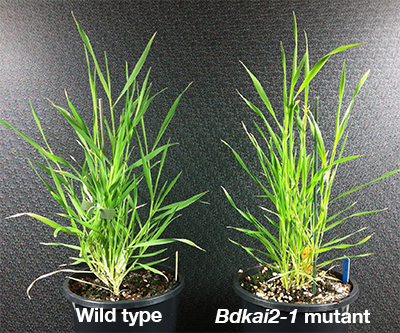 It was back in 2014 when I first thought it would be worthwhile looking into KAI2 signalling in a monocot – and Brachypodium seemed like a decent model that was easier to grow here in Oz than rice! Well finally – actually on Christmas Day 2021 – our findings from characterising two kai2 alleles in Brachypodium were published in The Plant Journal. You can read all about it there, in glorious Open Access format funded by a handy agreement between the publisher Wiley and German universities – but here I thought I might reflect on the process, to update the website and procrastinate over writing a grant application.
It was back in 2014 when I first thought it would be worthwhile looking into KAI2 signalling in a monocot – and Brachypodium seemed like a decent model that was easier to grow here in Oz than rice! Well finally – actually on Christmas Day 2021 – our findings from characterising two kai2 alleles in Brachypodium were published in The Plant Journal. You can read all about it there, in glorious Open Access format funded by a handy agreement between the publisher Wiley and German universities – but here I thought I might reflect on the process, to update the website and procrastinate over writing a grant application.
This work was a huge collaborative effort with first authors Yongjie Frank Meng from my lab, and Kartikye Varshney from Caroline Gutjahr’s lab, and substantial contributions in bioinformatics from Norbi and Eszter in Vilmos Sóos’ lab in Hungary. Identifying the mutants in the first place was only feasible thanks to hard work by many members of the Brachypodium research community, who established mutant populations and high-throughput screening methods. These people included co-authors Marion Dálmais, Richard Sibout, John Vogel and Debbie Laudencia-Chingcuanco.
Why did it take so long? In part it was because it was always a bit of a “side” project (kicked off by undergrad Lara!) that was not really prioritised until Frank joined the lab in 2018. Once an interesting phenotype emerged, of course we realised that a second mutant allele was essential to make a compelling set of results, so we had to scour the Brachy germplasm and screen a few more. Thankfully by this time HTP sequencing of the mutant populations meant that putative mutants could be identified from the desktop, rather than by TILLING screens as was the case for the first allele we found. And we got lucky with another strong allele, so we had our pair. Time to re-do everything, this time with both mutants. Then it was the briefest, Covid-19-cut-short visit to my lab by Eszter Badics that prompted us to do some RNA-seq and gain a little more insight into the basis for the mutant phenotypes – followed by a fair bit of tidying up loose ends by Muhammad, Sabrina and myself to wrangle the manuscript into a publishable state.
I wouldn’t say I was burned by Brachy, and I am absolutely glad that we undertook the work, but it was certainly a learning experience. It is not like growing Arabidopsis! Even getting the seeds to germinate was a challenge, which is a pain when you are supposedly working on germination stimulants (who knew you had to remove the glume first? And then they all germinate, synchronously!). The very different growth habits and architecture of monocots vs dicots brought me back to my very first research days working on photosynthetic mutants in maize – what’s that flappy-bendy bit at the bottom of the leaf blade again? can we use that as the node to determine internode length? Fun times. But of course, if you stick to Arabidopsis, with its insistent refusal to support arbuscular mycorrhizal associations, well you are missing out. Monocots just do it differently, and with style.
Thank you to all co-authors, and the ARC (Australia), DFG (Germany) and NKFIH (Hungary) for funding the work. Happy 2022 everyone!